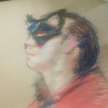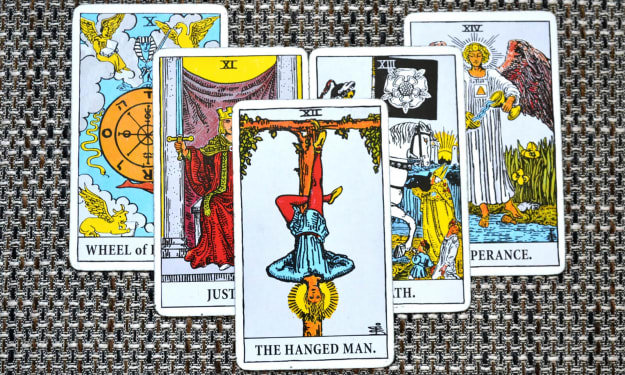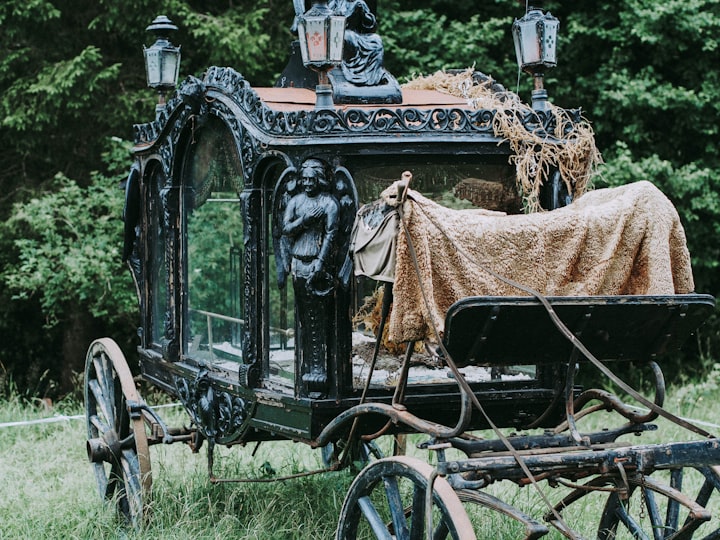Death Becomes Him/Her/Them
Queer Tarot, pt. 14

So it turns out actually doing things you think you're too tired to do because of post covid chronic fatigue, actually makes you feel a little bit better - so, onwards with my Queer Tarot series!
This series gives LGBTQIA+ people's perspectives on Tarot cards. Tarot is a set of symbols added on to playing cards, depicting a spiritual journey, used for meditation or fortune telling. Catch up with the characters we've met so far by clicking on these links for The Fool, The Magician, The High Priestess, The Empress, The Emperor, The Hierophant, The Lovers, The Chariot, Strength, The Hermit, the Wheel of Fortune, Justice, and the Hanged Man. The version that's thought of as the basic traditional Tarot, from which the myriad of decks are influenced and inspired, was drawn by mixed race bisexual lady Pamela "Pixie" Colman Smith, whose insights I'm sure made it into this art commission given her by straight white men. So I asked LGBTQIA+ Tarot users online to give me their viewpoints on the cards, and the result is this series!
Today we're giving the Queer Eye to something people get scared of, unless they learn to see around to the positive side - the Death card.
The most basic of Tarot readers will tell you it's a symbolic death, not a physical one - a finding of peace, or regeneration. Figures of all different genders and stations in life, from peasant to prince to priest, are all the same skeleton underneath. Even the most basic of life affirmations like, everyone being the same underneath and all differences being skin deep, can sometimes mean the world to a queer reader.
If I might indulge my own inner ancient history geek for a minute - one of the transphobic trollings that comes up boringly often is "When they dig up old bones on historic sites, it's always a male or a female, not any of the other millions of genders you made up"; and I love having an easy and obvious answer ready: There are plenty of places, from old Mesopotamia all the way to Scandinavia, where the bones might seem masculine but the goods they're buried with are typical female ones, or vice versa, feminine bones with typical male grave goods; and when they study their genetics, they've even found evidence to suggest androgynous appearance when the person was alive. But why would irrational people let facts get in the way of their bigotry?
Anyway, back to the card and its meanings!
The next most prominent symbol besides the skeleton figure is its flag of the white rose - this is an image with a wealth of spiritual and religious meanings. A white rose sat above the door of a traditional catholic confessional box, and everything said "under the rose" - Sub Rosa - was kept quiet and confidential. I have very little time for the catholic way of confession, but the unburdening of the past so that we can move forward into the future is a powerful thought or queer readers, considering what they may have gone through to get there. There was a time when brothels also had white roses above their doors and on their beds, to send the message that whatever happened in that bedroom, your secret was as safe and sacred as a confession to a catholic priest. Occultists and esotericists like to point to the way the white rose is associated with Mary Magdalene, as if it points to her being upheld as a holy woman; but my guess would be it's a throwback to the white rose being a brothel symbol too, as she was for too long vilified as a prostitute. Being a prostitute, of course - holy or otherwise - is nothing she deserves to be vilified for in the first place; one of my many problems with strict church moral codes! Many queer people find their place in life as a sex worker, and while it's often painted by the outside world as a place of bondage, that will be because the person going into it is unwilling, or had no choice; for many who go into sex work willingly and happily by choice, it can instead be a place of great freedom, for themselves and their clients. A stripping away of the outside world's standards and expectations, to be what you desire and know that you are what others desire too. Just like the Death card symbolises.
The ideas connected with Mary Magdalene bring out my history geek side again, especially when it comes to the Tarot. In the fringe christian philosophies usually dismissed as "heresy" by mainstream church, known as Gnostic (Remember those "secret gospels" kept out of the bible, that come up in books and films like The Da Vinci Code? Well those adventure stories may not be true, but those "other gospels" are real) Mary Magdalene is revered as a kind of Female Christ, and that idea becomes surprisingly important to a queer reading of the Tarot when you look at the queer history of the Tarot. Pixie - the Tarot artist we talked about at the start - the one who "never married but left all her money to a woman with whom she shared a flat", according to her bio, if you know what I mean - was given the Tarot themes to illustrate by the writer of the guidebook that went with it: A.E. Waite. He was influenced and inspired by the older occultist Eliphas Levi; he, in turn, was inspired by ritualist Simon Ganneau, who adopted the title Mapa, a combination of Mama and Papa. He/they dressed accordingly when leading meetings, rituals and ceremonies, and was accused of a heresy called Evadaism, a name made up by combining the names of Adam and Eve - who the Gnostics believed was the Divine Androgyne, only later split into the two archetypal ancestors in the Garden of Eden. He/they, finally, were part of a proto-socialist, proto-feminist school of thought called Saint-Simonian, named after the man who started it; and he/they, in turn, was a proponent of the "female messiah" idea, believing that was what patriarchal Christianity needed to restore its balance.
When we get as far as the Devil card in this series - the other card that scares people until they stop and think of the good things it can mean - you'll see the androgyny written into the very design of that figure.
Apart from being fascinating bits of history, I hope these things give my gay, trans, nonbinary, ace, and variations-of-the-above, readers an extra layer of depth in their readings of the Tarot.
Before I finish, let me lastly direct your eyes to the horizon of Pixie's image, where the Sun - which, in philosophies like the ones the Tarot is based on, often symbolises the inner spark of the divine - is to be found by going into the middle space between the two binary pillars; and leave you with the thoughts I obviously want that to bring to the mind of my fellow queer Tarot readers.
~*~
To find me for your own online Tarot reading, from the perspectives I've been talking about, click Here. To join my LGBTQIA+ Tarot group on bookface, click Here.
About the Creator
Mx. Stevie (or Stephen) Cole
Genderfluid
Socialist
Actor/actress
Tarot reader
Attracted to magic both practical & impractical
Writer of short stories and philosophical musings
Reader insights
Outstanding
Excellent work. Looking forward to reading more!
Top insights
Compelling and original writing
Creative use of language & vocab
Easy to read and follow
Well-structured & engaging content
Excellent storytelling
Original narrative & well developed characters
Expert insights and opinions
Arguments were carefully researched and presented
Eye opening
Niche topic & fresh perspectives
Heartfelt and relatable
The story invoked strong personal emotions
Masterful proofreading
Zero grammar & spelling mistakes
On-point and relevant
Writing reflected the title & theme






Comments (1)
Nice!